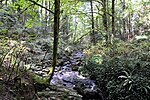Maurice Crumpacker House
1923 establishments in OregonHouses completed in 1923Houses on the National Register of Historic Places in Portland, OregonOregon Registered Historic Place stubsPortland Historic Landmarks ... and 1 more
Use mdy dates from August 2023

The Maurice Crumpacker House is the former residence of Maurice E. Crumpacker, a popular Oregon attorney and United States Congressman in the 1920s. The house was built by Portland architect Wade Hampton Pipes in 1923, and is located in the Dunthorpe neighborhood of Multnomah County, Oregon, just outside the Portland municipal boundary. It was added to the National Register of Historic Places in 1992.
Excerpt from the Wikipedia article Maurice Crumpacker House (License: CC BY-SA 3.0, Authors, Images).Maurice Crumpacker House
South Iron Mountain Boulevard, Portland Dunthorpe
Geographical coordinates (GPS) Address Nearby Places Show on map
Geographical coordinates (GPS)
| Latitude | Longitude |
|---|---|
| N 45.433017 ° | E -122.65837 ° |
Address
South Iron Mountain Boulevard 12714
97219 Portland, Dunthorpe
Oregon, United States
Open on Google Maps









